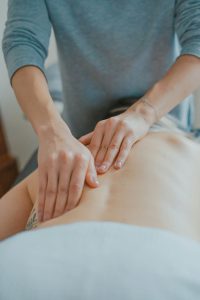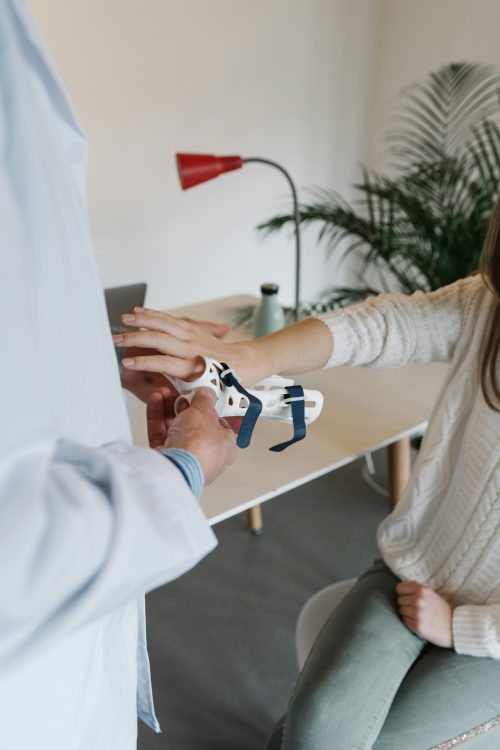When physical stress exceeds the tissue’s ability to heal or adapt, damage occurs, collectively referred to as overuse syndromes. More precisely, this stress is not one-time but cumulative, meaning small damages occur over a certain, usually longer, period.
Overuse syndromes
Description
When that stress is sudden and short-term, it is a trauma. These two phenomena may sometimes cause similar damage, but their cause and origin are different. A good example of this is muscle injuries. If you suddenly and unexpectedly slipped and did a “split,” a muscle rupture would occur, which is of a traumatic type. However, if an athlete, after warming up and preparing, during a sprint or a sudden change of direction, experiences that same rupture, it is the final result of a long overuse process that ended with the same outcome. Such examples are exceptions. Pain and tissue damage in overuse syndromes develop gradually and can affect all parts of the locomotor system:
Tendons and their attachments
Tendons and connective structures under the microscope look like a rope—a lot of thin fibers arranged parallel and packed tightly together. Small damages to one or more fibers do not trigger inflammatory processes but usually stimulate adaptive ones, which gradually make the tendon stronger, more elastic, and more resistant to stress. When repeated physical stress is of such magnitude and frequency that it does not allow for the mentioned adaptation, the damage accumulates until it causes tissue changes accompanied by inflammation and pain. Such inflammation is typically chronic from the very beginning and does not end with healing, accompanied by persistent pain that does not subside with rest or reduced physical load.
Bones
Bones usually handle tensile and compressive forces excellently. If physical activity increases gradually in volume and intensity, bone adaptation increases its density and elasticity, thus improving resistance to physical stress. When the upper threshold of bone adaptation is exceeded, injuries can occur at two levels. The first is bone inflammation or osteitis. It is characterized by pain and inflammation visible on MRI scans but without signs of cracks or fractures. The most common is osteitis of the pubic bone, especially in football players. It is a relatively benign injury, but recovery is prolonged. The second, more severe form of overuse bone injury is the stress fracture. It begins with the same symptoms as osteitis—pain and difficulty moving—but early MRI scans may reveal a fracture line (in English, hairline fracture, a small, thin, barely visible crack). After a few weeks, this crack is visible even on X-rays. The most common locations for these bone injuries are the foot and ankle, due to their anatomy, role in shock absorption during jumping and running, and circulatory peculiarities. However, stress fractures can occur in almost any bone in the body.
Muscles
For a long time, it was thought that every muscle rupture or injury was trauma. The logic behind this stance was that pain and damage occur suddenly, not gradually. Some professionals still adhere to this rule. However, time, experience, clinical practice, and certain studies have shown that there are two types of muscle ruptures, just as explained in the introduction to this text. The physiological basis of damage resulting from overuse syndromes remains largely unresolved. More about muscle injuries can be found on these pages (click to read article). For this discussion, it is sufficient to say that untreated or poorly managed muscle ruptures can transition into chronic conditions that are difficult and lengthy to treat and have been and still are the cause of many promising sports careers ending prematurely.
Joints (cartilage)
Whether cartilage damage in joints is an overuse syndrome or belongs to another group, the so-called cumulative damage of the locomotor system, is a debate that will not end quickly. Without delving into details, it might be best to view initial cartilage damage as overuse syndromes, which, if untreated or unrecognized, progress into cumulative or degenerative damage and diseases. A particular problem is recognizing early cartilage damage, as it lacks mechanical or pain sensors, meaning it does not hurt, and is poorly or not at all visible even on the most modern MRI devices. By the time we finally see it, the damage is significant enough to fall into the degenerative or traumatic subcategories of damage. Thus, the debate about whether they are overuse syndromes continues.
 When discussing overuse syndromes, we tend to think of extreme physical exertion or sports activities as their primary cause. However, the reality behind these conditions is more complex. Some of the most common variations are the so-called tennis elbow, golfer’s elbow, and plantar fasciopathy, also known as the popular “heel spur”, painful heel (click to read). These are relatively rarely the result of sports activities and are much more often caused by static activities, such as computer work, standing, or walking. These activities may not seem like significant forces acting on a small part of the locomotor system. Here, the complexity of our body comes into play—it has not evolved to maintain prolonged static positions or has lost the ability to absorb shock in certain areas (most often the foot or hand). In such an environment, even mild loads, sustained over a long period without compensatory physical activity to counterbalance the static positions, result in the same processes as overuse from physical exertion or sports. The result is always tissue damage accompanied by chronic inflammation, which heals extremely slowly or not at all.
When discussing overuse syndromes, we tend to think of extreme physical exertion or sports activities as their primary cause. However, the reality behind these conditions is more complex. Some of the most common variations are the so-called tennis elbow, golfer’s elbow, and plantar fasciopathy, also known as the popular “heel spur”, painful heel (click to read). These are relatively rarely the result of sports activities and are much more often caused by static activities, such as computer work, standing, or walking. These activities may not seem like significant forces acting on a small part of the locomotor system. Here, the complexity of our body comes into play—it has not evolved to maintain prolonged static positions or has lost the ability to absorb shock in certain areas (most often the foot or hand). In such an environment, even mild loads, sustained over a long period without compensatory physical activity to counterbalance the static positions, result in the same processes as overuse from physical exertion or sports. The result is always tissue damage accompanied by chronic inflammation, which heals extremely slowly or not at all.
In very simple terms, inflammation is the process of healing injured or damaged tissue.
It has three phases—acute, subacute, and remodeling. In the acute phase, pain is the most intense, and biological processes aim to quickly create a “patch” to prevent further injury progression, much like a scab forms on the skin when it’s damaged. This phase lasts a few days and then transitions into the subacute phase, during which healing occurs either with the original damaged tissue or, more commonly, with scar tissue. This scar is irregular, often larger than necessary, and its fibers are disorganized, with a mild inflammatory process still active. After several weeks, the subacute process ends, transitioning into the remodeling phase, during which the body gradually replaces the bulky and irregular scar with a smaller one, composed of connective fibers aligned with the dominant forces acting on the injured tissue. This phase can last for months and concludes with final healing. Only then has the inflammatory process fully completed its task. All these phases, from the initial injury to the completion of healing, are also referred to as the inflammatory cascade.
There is also a variant of the inflammatory process that is not beneficial to us, known as chronic inflammation. It begins similarly to the acute process but gets stuck halfway through. It is characterized by hypervascularization (many capillaries in the surrounding area), pain, and changes in the inflamed tissue that do not lead to healing. It’s as if the inflammatory cascade is stuck in a dead-end and perpetuates itself in a vicious cycle. Such processes are undesirable anywhere in the body and can be caused mechanically, as well as by various other factors such as degenerative processes, autoimmune diseases, chemical influences (like smoking), and more.
In overuse syndromes, chronic inflammation caused by mechanical reasons is at play, and it requires therapeutic intervention that can take one of two directions, depending on the level of the inflammatory process, the duration of symptoms, the location of the damage, and other factors. One approach focuses on calming the inflammatory reaction and stimulating scar remodeling through manual therapy methods, biological stimulation, and an appropriate exercise regimen aimed at normalizing the mechanical and biological properties of the injured tissue. The other approach focuses on intensifying or initiating a new inflammatory cascade to achieve final healing. This involves stimulation methods such as shockwave therapy, friction massage, isolated eccentric contractions, and others. This is localized therapy targeting the damage itself.
Global therapeutic interventions begin by identifying the root cause of the primary issue, whether near or far from the painful syndrome, and continue by addressing the detected deficiencies to remove the foundation for potential recurrence of the painful syndrome. Detailed information on all these interventions can be found on this site through texts that address specific overuse syndromes.
Additionally, for each group of these conditions and for each specific painful state, there are multiple predisposing factors that increase the risk of their occurrence. Detecting these factors through examinations, medical tests, kinematic assessments, and diagnostic training processes gives us the tools for specific prevention in individual cases. Such processes are regularly implemented behind the scenes for most top athletes or sports teams (clubs or national teams), or at least they should be.
General prevention of overuse syndromes is relatively simple, but from experience, I can confirm that even such accessible and universally understandable protocols often prove unfeasible in practice, mainly due to entrenched, often outdated views on training, training loads, fatigue, pain during training, and logistical shortcomings, such as the absence of appropriate specialized medical care, lack of communication within the sports medicine team (which includes the coach, conditioning coach, physiotherapist, and doctor, as well as other specialists), and the attitudes of the athletes themselves.
General prevention of overuse syndromes in sedentary or physically inactive individuals:
Physical activity. There is a reason why the locomotor system is called as such. To function well, it simply requires movement. This movement doesn’t necessarily have to be sport with peak and intense loads but can also include moderate activities such as yoga, Pilates, walking, stretching exercises, and similar combinations. If your overall physical condition is poor, you have chronic illnesses, or you’re simply unsure where and how to start, a consultation with a physiotherapist can be highly beneficial. Individual exercise programs based on the results of such an assessment are a safe starting point for a better-functioning, healthier, and more capable locomotor system, which will be less prone to damage and painful conditions. Ultimately, the goal is always to feel good in your own body.






